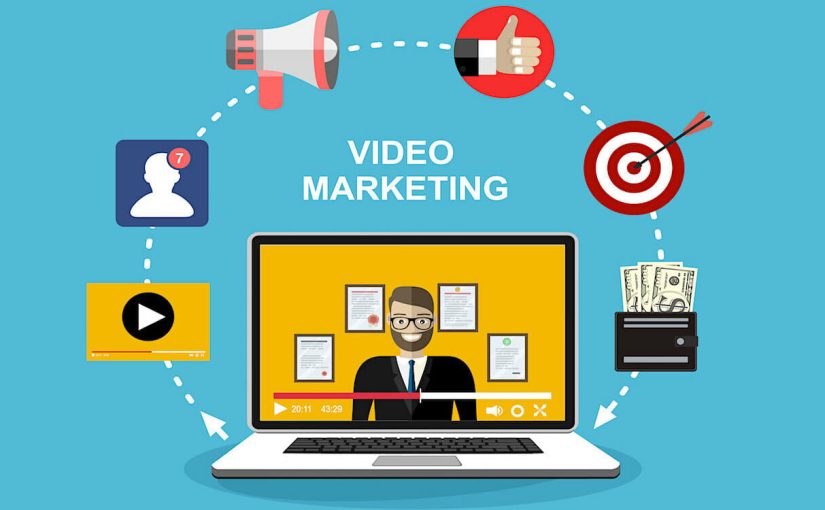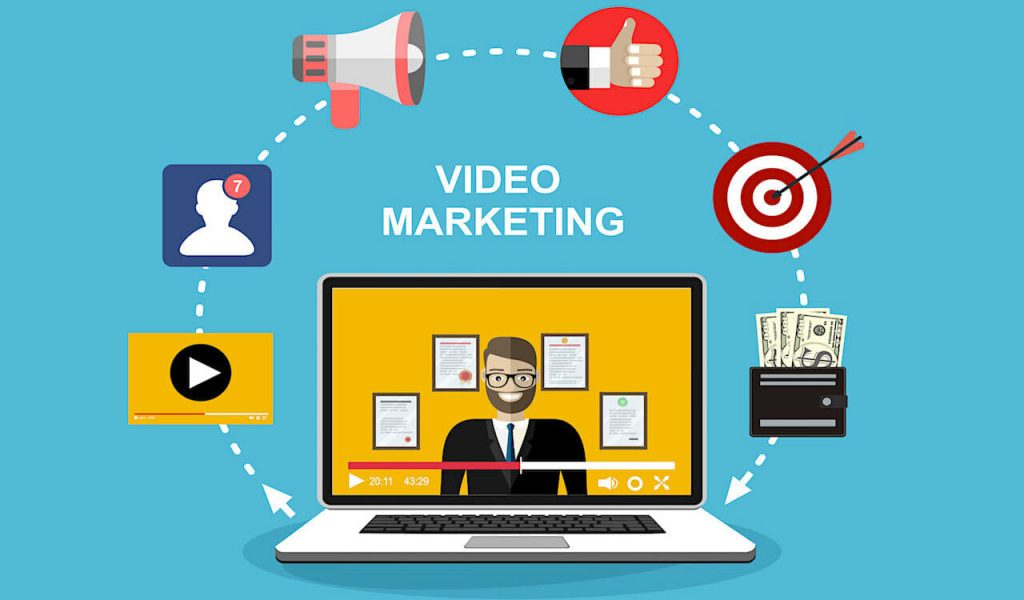Video marketing uses videos to promote and market your product or service, increase engagement on your digital and social channels, educate your consumers and customers, and reach your audience with a new medium.
What Is Video Marketing?
Video marketing refers to using video to market or promote your brand or offering on digital channels.
In simple terms, when you use video for marketing your brand, product, or service, engage on social media channels, educate prospective and current customers, and interact with them, you’re said to be using video marketing.
Why Is Video Marketing Gaining Importance?
According to a survey by Wyzowl –
76% of the businesses which use video marketing believe that it results in a good ROI.
93% of companies think it increases user understanding of their product or service.
And 72% of businesses believe that it has improved the conversion rate of their website.
It’s not just the businesses inclined towards using video as a marketing device; customers are more willing to receive marketing messages in the form of videos. According to a report from Hubspot Research, over 50% of customers prefer video over other types of content from a brand.
Videos have revolutionized how brands connect with customers. They have changed how a brand sells, how customers shop, consumers consume, and how service teams maintain relations with the customers.
Businesses use videos on their landing pages (to explain how offering works and its benefits), social media posts (to engage with the audience), blogs (to retain more readers), and even emails (to support their marketing campaigns). Out of them, 83% believe their home page explainer video to be compelling, 78% believe video on social media to be a great tactic, and 80% believe videos in emails bring in the required ROI.
Types Of Video Content
Video content used in video marketing strategies includes but isn’t limited to –
Product Demo: In-depth videos which explain the products’ USP, features, and benefits. It is designed to showcase customers’ utility after buying the offering.
Interviews: Interview includes asking questions to a thought leader on a particular topic and posting its video online.
Testimonials: Testimonials are videos of happy and renowned company customers expressing their appreciation and good experience with the company. This helps in increasing the confidence of prospective buyers.
Event Videos: These videos cover an event’s highlights and are usually part of the event marketing strategy.
Explainer Videos: Explainer videos are usually used to answer the FAQs related to the offering.
How-To Videos: How-to videos explain the how-to aspect of the offering and teach the new or existing customers how to use it or any of its features.
Vlog: Vlogs or video blogs are video versions of traditional blogs. Through vlogs, a business executes its marketing strategies using videos.
Webinars: Webinars or web-based-seminars are live, web-based video conferences where the host uses an internet connection to connect with the audience of viewers and listeners worldwide and talk about a specific topic.
Presentations & Talks: These include posting recorded videos of presentations and talks someone related to the business has organized, delivered, attended, or was a part of. Such words (like Tedx) are much sought-after video content on the internet.
Tutorials: Tutorials are in-depth videos to teach the customers the intricacies of the offering or other offering the business is affiliated with.
Reviews: These are the reviews of the product or services posted by influencers and thought leaders, which alter the viewers’ decisions.
Behind The Scenes: Many businesses often release behind-the-scenes videos, which help them establish a closer relationship with the customers, who get to experience what they usually don’t see in advertisements or on TV.
Live Videos: Live videos are videos related to the brand or offering streamed live to showcase something important or to interact with the customers directly.
How To Do Video Marketing
There’s a lot that goes into video marketing. It would help if you planned what you have to make, for whom you have to make it, how to make it, and how to reach the audience once it is developed.
Determine Your Goals
This is an essential step before anything begins.
Define what you want to achieve using videos. Is it more sales that you’re seeking? Or is it more social media followers? Viral marketing? Word of mouth marketing? More retained customers?
It would help if you were explicit regarding goals, as different plans are supported by different video marketing strategies and produce different results. To increase sales, you might need to create a demo or explainer video, which you can publish on your landing page. For viral marketing, however, you might need to develop a witty advertisement or a social media campaign with dedicated hashtags and a series of videos.
Most of the time, video marketing isn’t used as a stand-alone marketing strategy. But even if you do, make sure how you’re going to measure the ROI.
Plan Your Video(s)
Once the goal is set, you need to plan your video(s) next. Determine and define your –
Target audience: The target audience constitutes the people for whom the video is developed. They can either be your existing customers, prospective customers, or other people who influence the decisions of your customers or prospective customers. Knowing your target market is essential as it helps develop the video message.
Video Message: What will the video be about? Video message makes it straightforward for the internal audience what the brand wants to showcase or communicate to the target audience.
Video platform: Different video platforms have different value propositions. While some (like Vimeo) let you seamlessly embed your videos on other platforms, some are great for SEO (YouTube), and some (Facebook) helps you target the people on social media. You can choose a single platform or a mix of other platforms to host and share your videos.
Budget: Budget is an essential factor guiding other video development and marketing decisions.
Script: The script becomes the base of the video and is a big reason behind the success or failure of the video marketing strategy.
Video Type: Defining the type of video is vital as it decides how it is developed, posted, and marketed. Live videos usually involve shooting and posting simultaneously, while explainer videos may use animations and other shots and can take a lot of edits. Deciding upon the video type earlier makes it easy to determine the creative requirements, timeline, and other video requirements.
Creative Requirements: These depend on the type of video. It may include costumes, location permissions, digital assets, etc.
Plan of action: It states what is to be done at what time. It simplifies the strategizing and execution.
Other requirements: Other video-specific requirements that are needed to be planned.
Develop Your Video(s)
This stage involves shooting the video, adding fx, background score, voice-over, and everything required to convert the written script into moving frames.
This stage often involves taking the help of a third party to shoot the video or develop the animations for you. But if you want to do it yourself, here are some tools to help you with the same –
Animoto: A cloud-based video editing SAAS that you can use to create videos online using thousands of templates and features.
Place: Placeit is a very easy-to-use drag-and-drop video development platform with templates for almost every type of video, from Instagram stories to promo videos to Facebook ads.
Envato: Envato elements is a subscription service for video creators that provides you with hundreds of thousands of digital assets.
Market Your Video(s)
Even though videos are considered to be a great asset when it comes to marketing, you need to market them too.
If you upload it on YouTube or your website, focus on SEO. Use relevant hashtags if you choose Instagram or Twitter as your preferred platform. You can even share it on other social media platforms like Reddit or Tumblr or run an ad for the same (video ads perform better than image ads), which can help you get more traction to fulfill your goals.
Benefits of Video Marketing
More people are watching videos, but what does that mean for your business? Let’s consider some quantifiable reasons why video marketing is so powerful today.
Videos are Effective
Videos are your best bet for informing and educating prospective and current customers about your product or service. 97% of marketers agree that video helps customers better understand their products. Nothing beats a close-up look at the product you’re promoting, not even the most descriptive copy.
Also, videos have the highest information retention rate of any media. Your audience retains 95% of your message when watching a video but only 10% when they read text.
Videos Boost Conversion
About half of internet shoppers now look for product-related videos before making a purchasing decision, and 90% say that demo videos are helpful. What’s more? 85% of those consumers are more likely to buy after watching a product demo. So, if you have a product or landing page that hasn’t been doing so well, it might be time to add a product demo video or an explainer video.
Several studies have found that sales pages that have videos convert better than those that don’t. There may be several reasons for this, but one of them is that videos keep visitors on your page longer.
Videos Are Great For SEO
Videos now appear in 70% of the top 100 Google search listings. Search engine bots can transcribe your video’s audio and serve it to the right audience. Adding videos to your marketing campaign makes it more discoverable, allowing you to generate free traffic.
You can increase your website visits by adding your link to the description of properly optimized videos targeted at your audience.
Video Complements other Marketing Strategies
It’s not difficult to add videos to your existing marketing strategies. For instance, you can make a video version of your blog and add it to your blog or post it to YouTube with a link back to your site.
Videos can also improve email click-through and open ratios. Including the word “video” in the subject line can help increase available rates by 19%, boost click-through rate by 65%, and reduce un-subscriptions by 26%.
Wrapping Up
Video marketing is not new, but as video becomes more accessible, people consume more video content over text. Your company can enjoy higher returns with video marketing if you can creatively use videos to support your business goals and customer needs.




